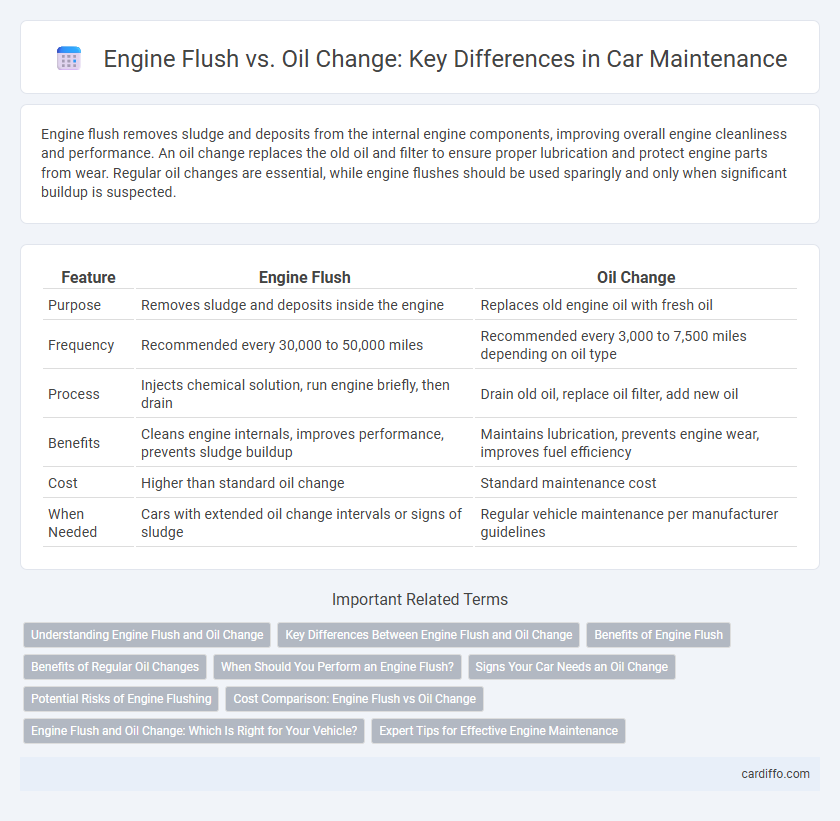Engine flush removes sludge and deposits from the internal engine components, improving overall engine cleanliness and performance. An oil change replaces the old oil and filter to ensure proper lubrication and protect engine parts from wear. Regular oil changes are essential, while engine flushes should be used sparingly and only when significant buildup is suspected.
Table of Comparison
| Feature | Engine Flush | Oil Change |
|---|---|---|
| Purpose | Removes sludge and deposits inside the engine | Replaces old engine oil with fresh oil |
| Frequency | Recommended every 30,000 to 50,000 miles | Recommended every 3,000 to 7,500 miles depending on oil type |
| Process | Injects chemical solution, run engine briefly, then drain | Drain old oil, replace oil filter, add new oil |
| Benefits | Cleans engine internals, improves performance, prevents sludge buildup | Maintains lubrication, prevents engine wear, improves fuel efficiency |
| Cost | Higher than standard oil change | Standard maintenance cost |
| When Needed | Cars with extended oil change intervals or signs of sludge | Regular vehicle maintenance per manufacturer guidelines |
Understanding Engine Flush and Oil Change
Engine flush involves circulating a cleaning solvent through the engine to remove sludge, deposits, and contaminants, improving internal cleanliness and performance. An oil change replaces old, degraded motor oil with fresh oil and a new filter to ensure optimal lubrication and protect engine components. Understanding the distinct purposes helps maintain engine health by choosing the right procedure based on the vehicle's condition and manufacturer recommendations.
Key Differences Between Engine Flush and Oil Change
Engine flush involves circulating a chemical solution through the engine to remove sludge, deposits, and contaminants, while an oil change replaces the old oil and oil filter with fresh lubricating oil. Engine flush targets deep cleaning of internal engine components to improve performance and prevent buildup, whereas oil changes maintain engine lubrication and protect against wear. Choosing an engine flush depends on the engine's condition and maintenance history, whereas oil changes are routine maintenance essential for engine longevity.
Benefits of Engine Flush
Engine flush removes sludge, deposits, and contaminants from the internal engine components, enhancing overall engine performance and fuel efficiency. It helps prevent future buildup that can cause costly repairs and extends the lifespan of engine parts by ensuring cleaner oil flow. Regular engine flushes support smoother operation and reduce emissions, contributing to better vehicle reliability and environmental impact.
Benefits of Regular Oil Changes
Regular oil changes enhance engine performance by maintaining optimal lubrication, reducing friction, and preventing wear on crucial components. They help remove contaminants and sludge that accumulate over time, ensuring cleaner engine internals and longer engine life. Consistent oil replacement also improves fuel efficiency and reduces the risk of costly engine repairs compared to relying solely on engine flush treatments.
When Should You Perform an Engine Flush?
Perform an engine flush when your vehicle exhibits symptoms like excessive engine sludge, poor oil circulation, or after operating in harsh conditions such as frequent stop-and-go traffic or extreme temperatures. Manufacturers typically recommend an engine flush every 30,000 to 50,000 miles to maintain optimal engine performance and longevity. An engine flush is particularly beneficial before an oil change to remove contaminants and ensure clean oil flow throughout the engine components.
Signs Your Car Needs an Oil Change
Dark, dirty oil and increased engine noise are clear signs your car needs an oil change rather than just an engine flush. Reduced fuel efficiency and dashboard oil warning lights indicate degraded oil quality requiring immediate replacement. Regular oil changes prevent sludge buildup that an engine flush alone cannot effectively remove.
Potential Risks of Engine Flushing
Engine flushing can remove sludge and deposits but poses potential risks such as dislodging large debris that may clog oil passages, leading to reduced lubrication efficiency. Using chemical additives during flushing might degrade seals or gaskets, causing leaks or engine damage. Frequent or improper engine flushing increases the likelihood of mechanical wear and costly repairs compared to routine oil changes.
Cost Comparison: Engine Flush vs Oil Change
Engine flush services typically cost between $50 and $100, making them significantly more expensive than a standard oil change, which averages around $30 to $70. While oil changes are routine maintenance essential for engine longevity, engine flushes serve as a deep cleaning process and are recommended less frequently, impacting the overall maintenance budget differently. Choosing between the two depends on the vehicle's condition and maintenance history, which influences the cost-effectiveness of each service.
Engine Flush and Oil Change: Which Is Right for Your Vehicle?
Engine flush involves using a special chemical additive to clean sludge and deposits from the engine's internal components, improving performance and efficiency. An oil change replaces the old oil and filter to maintain proper lubrication and prevent engine wear. Choosing between an engine flush and an oil change depends on your vehicle's condition, mileage, and manufacturer recommendations.
Expert Tips for Effective Engine Maintenance
Engine flush and oil change are crucial for maintaining engine health, but each serves different purposes; an engine flush removes sludge and deposits from deep within the engine, while an oil change replaces old oil with fresh lubricant to ensure proper engine performance. Experts recommend performing an engine flush every 30,000 to 50,000 miles depending on the vehicle's condition, followed by regular oil changes every 3,000 to 7,500 miles with the manufacturer-recommended oil grade. Prioritizing both processes enhances engine longevity, improves fuel efficiency, and reduces the risk of costly repairs.
Engine flush vs oil change Infographic

 cardiffo.com
cardiffo.com